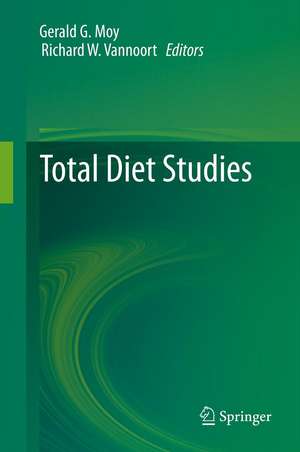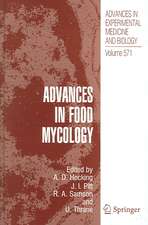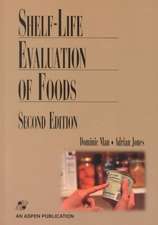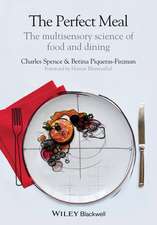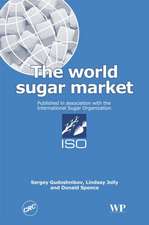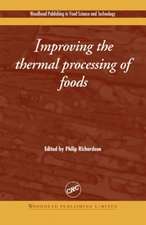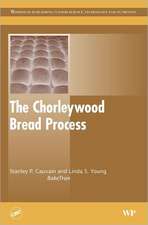Total Diet Studies
Editat de Gerald G. Moy, Richard W. Vannoorten Limba Engleză Hardback – 7 noi 2013
The goal of a total diet study (TDS) is to provide basic information on the levels and trends of exposure to chemicals in foods as consumed by the population. In other words, foods are processed and prepared as typical for a country before they are analyzed in order to better represent actual dietary intakes. Total diet studies have been used to assess the safe use of agricultural chemicals (e.g., pesticides, antibiotics), food additives (e.g., preservatives, sweetening agents), environmental contaminants (e.g., lead, mercury, arsenic, cadmium, PCBs, dioxins), processing contaminants (e.g., acrylamide, polycyclic aromatic hydrocarbons, chloropropanols), and natural contaminants (e.g., aflatoxin, patulin, other mycotoxins) by determining whether dietary exposure to these chemicals are within acceptable limits. Total diet studies can also be applied to certain nutrients where the goal is to assure intakes are not only below safe upper limits, but also above levels deemed necessary to maintain good health. International and national organizations, such as the World Health Organization, the European Food Safety Agency and the US Food and Drug Administration recognize the TDS approach as one of the most cost-effective means of protecting consumers from chemicals in food, for providing essential information for managing food safety, including food standards, and for setting priorities for further investment and study.
Total Diet Studies introduces the TDS concept to a wider audience and presents the various steps in the planning and implementation of a TDS. It illustrates how TDSs are being used to protect public health from chemicals in the food supply in many developed and developing countries. The book also examines some of the applications of TDSs to specific chemicals, including contaminants and nutrients.
| Toate formatele și edițiile | Preț | Express |
|---|---|---|
| Paperback (1) | 957.94 lei 6-8 săpt. | |
| Springer – 22 aug 2016 | 957.94 lei 6-8 săpt. | |
| Hardback (1) | 963.15 lei 6-8 săpt. | |
| Springer – 7 noi 2013 | 963.15 lei 6-8 săpt. |
Preț: 963.15 lei
Preț vechi: 1174.58 lei
-18% Nou
Puncte Express: 1445
Preț estimativ în valută:
184.32€ • 191.26$ • 154.06£
184.32€ • 191.26$ • 154.06£
Carte tipărită la comandă
Livrare economică 18 martie-01 aprilie
Preluare comenzi: 021 569.72.76
Specificații
ISBN-13: 9781441976888
ISBN-10: 1441976884
Pagini: 675
Ilustrații: XXVI, 550 p. 74 illus., 45 illus. in color.
Dimensiuni: 155 x 235 x 38 mm
Greutate: 0.95 kg
Ediția:2013
Editura: Springer
Colecția Springer
Locul publicării:New York, NY, United States
ISBN-10: 1441976884
Pagini: 675
Ilustrații: XXVI, 550 p. 74 illus., 45 illus. in color.
Dimensiuni: 155 x 235 x 38 mm
Greutate: 0.95 kg
Ediția:2013
Editura: Springer
Colecția Springer
Locul publicării:New York, NY, United States
Public țintă
Professional/practitionerCuprins
Part 1. Conducting Total Diet Studies.-Total diet studies: What they are and why they are important.-The origin of total diet studies.-Risk analysis paradigm and total diet studies.-Overview of dietary exposure.-Scope, planning and practicalities of a total diet study.-Preparing a food list for a total diet study.-Selecting chemicals for a total diet study.-Preparing a procedures manual for a total diet study.-Food sampling and preparation in a total diet study.-Analyzing food samples: Organic chemicals.-Analyzing food samples: Inorganic chemicals.-Analyzing food samples: Radionuclides.-Quality control and assurance issues relating to sampling and analysis in a total diet study.-Commercial analytical laboratories: Tendering, selecting, contracting and managing performance.-Managing Concentration Data: Validation, security and interpretation.-Reporting and modelling of results below the limit of detection.-Dietary exposure assessment in a total diet study.-Addressing uncertainty and variability in total diet studies.-Communicating results in a total diet study.-Part 2. Experiences in Total Diet Studies.-The Australian experience in total diet studies.-Total diet study in Cameroon: A sub-Sahara African perspective.-Canadian total diet study experiences.-The Chinese experience in total diet studies.-The first total diet study in Hong Kong, China.-Experiences in total diet studies in the Czech Republic.-The present and future use of total diet studies by the European Food Safety Authority.-The first total diet study in Fiji.-The French total diet studies.-Total diet studies in the Indian context.-Experiences in total diet studies in Indonesia.-Total diet studies in Japan, Fujio Kayama.-Total diet studies in the Republic of Korea.-Dietary exposure to heavy metals and radionuclides in Lebanon.-The Malaysian experience in a total diet study.-New Zealand's experience in total diet studies.-Experiences in total diet studies in Spain.-Total diet study in the Basque Country, Spain.-Total diet studies in Catalonia, Spain.-Total diet studies in Sweden: Monitoring dietary exposure to persistent organic pollutants by a marketbasket approach.-Total diet studies: United Kingdom’s experience.-United States Food and Drug Administration’s total diet study program.-Part 3. Special Topics in Total Diet Studies.-GEMS/Food and total diet studies.-GEMS/Food Consumption Cluster Diets.-Food mapping in a total diet study.-Automated programs for calculating dietary exposure.-OPAL: A program to manage date on chemicals in food and the diet.-Involving and influencing key stakeholders and interest groups on a total diet study.-Linking nutrition surveys with total diet studies.-Emerging chemical contaminants in total diet studies in China.-Using total diet studies to assess acrylamide exposure.-Polybrominated diphenyl ethers in food in Australia: An additional use of the Australian Total Diet Study.-Risk assessment and management interface: Example of methylmercury in fish.-The German approach to estimating dietary exposures using food monitoring data.-Total diet studies for infants: Example of persistent organic pollutants in human milk.
Notă biografică
Gerald G. Moy: Formerly a scientist with the World Health Organization, Dr. Gerald Moy was responsible for the exposure assessment of chemical hazards and coordinated total diet studies at the international level through a network of WHO Collaborating Centers. Although retired, he remains active as a food safety adviser to the World Food Program, the Chinese National Food Safety Risk Assessment Center, the WHO Interdepartmental Mass Gatherings Group and the International Union of Food Science and Technology.
Richard W. Vannoort: A senior scientist with the Institute of Environmental Science & Research Ltd (ESR), Dr Richard Vannoort has been the scientific project leader of the last five New Zealand Total Diet Surveys. He is a leading international Total Diet Study expert and has been Technical adviser to the World Health Organization on TDSs, and other countries on numerous occasions, including international consultancies.
Richard W. Vannoort: A senior scientist with the Institute of Environmental Science & Research Ltd (ESR), Dr Richard Vannoort has been the scientific project leader of the last five New Zealand Total Diet Surveys. He is a leading international Total Diet Study expert and has been Technical adviser to the World Health Organization on TDSs, and other countries on numerous occasions, including international consultancies.
Textul de pe ultima copertă
Total Diet Studies is intended to introduce the total diet study (TDS) concept to those involved in assuring the safety of the food supply from chemical risks (e.g., government agencies and the food industry) as well as to a wider audience of interested parties (e.g., development agencies and consumer organizations). It presents the various steps in the planning and implementation of a TDS and illustrates how TDSs are being used to protect public health from the potential risks posed by chemicals in the food supply in both developed and developing countries. The book also examines some of the applications of TDSs to specific chemicals, including contaminants and nutrients.
The goal of a TDS is to provide baseline information on levels and trends of exposure to chemicals in foods as consumed by the population. In other words, foods are processed and prepared as typically consumed before they are analyzed in order to best represent actual dietary intakes. Total diet studies have been used to assess the safe use of agricultural chemicals (e.g., pesticides, antibiotics), food additives (e.g., preservatives, sweetening agents), environmental contaminants (e.g., lead, arsenic, cadmium, radionuclides), processing contaminants (e.g., acrylamide, polycyclic aromatic hydrocarbons, chloropropanols), and natural contaminants (e.g., aflatoxins) by determining whether dietary exposures to these chemicals are within acceptable limits. Total diet studies can also be applied to certain nutrients where the goal is to assure intakes are not only below safe upper limits, but also above levels deemed necessary to maintain good health. International and national organizations, such as the World Health Organization, the European Food Safety Agency, and the US Food and Drug Administration recognize the TDS approach as one of the most cost-effective means of protecting consumers from chemicals in food, for providing essential information for managing food safety, including food standards, and for setting priorities for further investigation and intervention.
About the Editors
Gerald G. Moy: For over twenty years, Dr. Moy served as a staff scientist with the World Health Organization and was primarily responsible for the exposure assessment of chemical hazards in food, including coordination of total diet studies at the international level. Although retired, he remains active as a food safety adviser for various national and international organizations.
Richard W. Vannoort: A senior scientist with the Institute of Environmental Science & Research Ltd (ESR), Dr. Vannoort has been the scientific project leader of the last five New Zealand Total Diet Studies. He is an internationally recognized expert on TDSs and has been a technical adviser to many countries, including numerous international and regional TDS training courses sponsored by the World Health Organization.
The goal of a TDS is to provide baseline information on levels and trends of exposure to chemicals in foods as consumed by the population. In other words, foods are processed and prepared as typically consumed before they are analyzed in order to best represent actual dietary intakes. Total diet studies have been used to assess the safe use of agricultural chemicals (e.g., pesticides, antibiotics), food additives (e.g., preservatives, sweetening agents), environmental contaminants (e.g., lead, arsenic, cadmium, radionuclides), processing contaminants (e.g., acrylamide, polycyclic aromatic hydrocarbons, chloropropanols), and natural contaminants (e.g., aflatoxins) by determining whether dietary exposures to these chemicals are within acceptable limits. Total diet studies can also be applied to certain nutrients where the goal is to assure intakes are not only below safe upper limits, but also above levels deemed necessary to maintain good health. International and national organizations, such as the World Health Organization, the European Food Safety Agency, and the US Food and Drug Administration recognize the TDS approach as one of the most cost-effective means of protecting consumers from chemicals in food, for providing essential information for managing food safety, including food standards, and for setting priorities for further investigation and intervention.
About the Editors
Gerald G. Moy: For over twenty years, Dr. Moy served as a staff scientist with the World Health Organization and was primarily responsible for the exposure assessment of chemical hazards in food, including coordination of total diet studies at the international level. Although retired, he remains active as a food safety adviser for various national and international organizations.
Richard W. Vannoort: A senior scientist with the Institute of Environmental Science & Research Ltd (ESR), Dr. Vannoort has been the scientific project leader of the last five New Zealand Total Diet Studies. He is an internationally recognized expert on TDSs and has been a technical adviser to many countries, including numerous international and regional TDS training courses sponsored by the World Health Organization.
Caracteristici
A reference in food safety courses in food science departments
Insights in how to monitor chemicals in the food supply to protect public health
Introduces the concept of total diet studies (TDS) to a wider audience.
Insights in how to monitor chemicals in the food supply to protect public health
Introduces the concept of total diet studies (TDS) to a wider audience.
